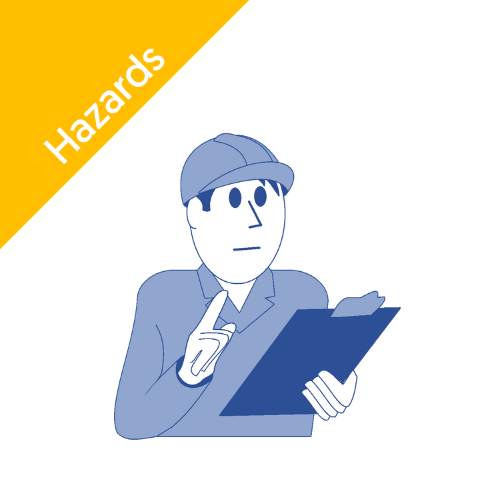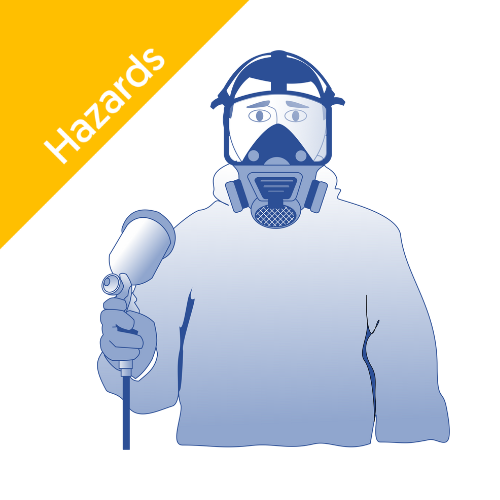Understanding Isocyanates and UK Law
Isocyanates are reactive chemicals used to manufacture polyurethane products such as foams, sealants, and coatings. Because of their potential to harm the skin’s protective barrier and cause respiratory sensitisation, their use is tightly regulated.
The main legislation governing the safe use of isocyanates is the Control of Substances Hazardous to Health (COSHH) Regulations 2002, enforced by the Health and Safety Executive (HSE). COSHH requires employers to assess, prevent, or control exposure to hazardous substances.
Additional relevant legislation includes:
Industries Most Affected by Isocyanate Regulations in the UK
Certain industries in the UK are more heavily affected by isocyanate regulations because their processes generate airborne mists, aerosols, or vapours, increasing the likelihood of exposure and respiratory sensitisation.
Key affected industries:
Motor Vehicle Repair (MVR): Vehicle spray painters and body-shop technicians are at high risk due to exposure to isocyanate-containing paint mists. HSE inspections frequently target this sector.
Construction and Insulation: Spray polyurethane foam (SPF) applicators face risks from airborne vapours and skin contact.
Furniture and Bedding Manufacturing: Foam production can expose workers to high concentrations of diisocyanates.
Adhesives, Sealants, and Flooring Applications: Fitters using two-component polyurethane products often face both inhalation and skin contact risks.
Industrial Coatings and Plastics Manufacturing: Workers exposed to aerosols and vapours during curing or coating processes require strict engineering controls.
HSE guidance emphasises the need for local exhaust ventilation (LEV), constant-flow air respirators, and substitution with less hazardous materials where possible. Employers in these industries are expected to maintain full COSHH documentation and evidence of regular monitoring.
See related guidance: Risk Assessment and Control Measures for Isocyanates for sector-specific best practices.
HSE Guidance on Managing Diisocyanate Processes
The HSE sets out clear expectations for employers managing diisocyanate or isocyanate-based processes. Recommended actions include:
Assess every task that could release isocyanates into the air, such as spraying, foaming, or coating.
Apply the hierarchy of control: start with elimination or substitution of hazardous materials where feasible.
Use engineering controls, including spray booths, LEV, and enclosed systems.
Provide air-fed respiratory protective equipment or constant-flow air systems for spraying tasks.
Supply and maintain suitable PPE, e.g. gloves, coveralls, eye protection, and respiratory protection appropriate to the task length and product type.
Refer to the product’s safety data sheet (SDS) for control guidance and PPE recommendations.
Conduct regular air monitoring and biological monitoring to confirm exposure is controlled.
Maintain equipment and keep detailed records of maintenance, inspections, and test results.
For more on training requirements, see: Safe Use of Diisocyanates – Training and Legal Compliance.
Employer Legal Responsibilities under COSHH
Under COSHH, employers must:
Carry out a risk assessment to identify where and how exposure may occur.
Prevent or control exposure through engineering solutions, safe systems of work, and PPE.
Maintain and test controls such as LEV and spray booths.
Provide training and supervision so employees understand risks, equipment use, and emergency procedures.
Monitor exposure levels through air sampling or biological testing.
Conduct health surveillance including lung function tests and skin checks.
Keep records of assessments, monitoring, and maintenance for inspection.
The HSE can issue improvement notices or take enforcement action if businesses fail to manage risks effectively.
What to Do if Isocyanate Exposure Is Detected
If exposure monitoring or health surveillance shows that workers have been exposed to isocyanates:
Stop the affected process immediately.
Inform workers and provide prompt occupational health assessment.
Investigate the cause and check ventilation, PPE condition, and RPE fit.
Review and update your COSHH risk assessment.
Report the incident under RIDDOR if occupational asthma or dermatitis is diagnosed.
Reinforce training to prevent future occurrences.
How Often Should UK Businesses Carry Out Isocyanate Exposure Testing?
Even with good controls in place, regular exposure testing ensures that systems remain effective. Under COSHH, testing frequency depends on the type of work, the length of the work task, and the risk level. The HSE guidance recommends:
Annual biological monitoring (urine testing) for workers who regularly handle isocyanates, especially vehicle spray painters and applicators.
Air monitoring should be conducted when:
New materials, including less hazardous alternatives, are introduced.
Ventilation or control systems are modified.
Health surveillance results suggest possible overexposure.
Routine re-testing is typically every 6 to 12 months in high-risk environments such as spray booths or foam application areas.
If exposure exceeds the Workplace Exposure Limit (WEL) or sensitisation symptoms are detected:
Consistent monitoring proves compliance, reduces isocyanate risks, and demonstrates due diligence during HSE inspections.
Learn more in our related article: Monitoring and Health Surveillance for Isocyanates.
Health Surveillance and Monitoring
Health surveillance is mandatory where there’s a risk of occupational asthma or dermatitis from isocyanate exposure. It typically includes:
Lung function testing and health questionnaires (usually annual).
Biological monitoring to detect isocyanate metabolites in urine.
Medical follow-up where early symptoms appear.
Monitoring ensures control measures remain effective and safeguards long-term worker health.
Training and Competence
Under UK REACH, workers using polyurethane products containing diisocyanates must complete approved training. Training ensures awareness of:
Health effects and safe working methods.
Correct use, fitting, and maintenance of PPE and RPE.
Emergency response procedures.
Training must be renewed every five years to stay valid.
If your organisation needs this training, Commodious offers COSHH Training Courses that meet legal requirements and support hazardous substance safety awareness for all staff.
Conclusion
Managing isocyanates safely is both a legal and ethical duty. Employers must perform COSHH risk assessments, apply suitable control measures, and ensure all staff are trained and monitored.
By following HSE guidance, using proper PPE and ventilation, and adopting less hazardous materials where possible, you can protect workers, maintain compliance, and build a culture of safety in your workplace.
Further Reading






